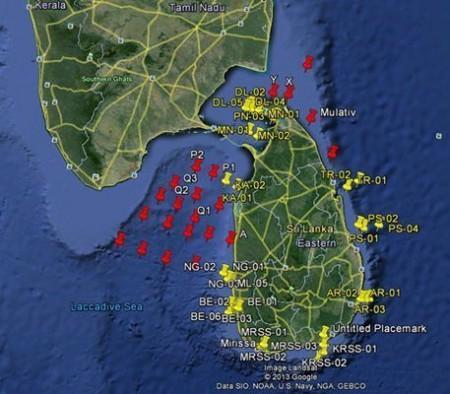 This map shows the sampling locations around the waters of Sri Lanka. Yellow dots:
This map shows the sampling locations around the waters of Sri Lanka. Yellow dots: analyses of samples completed; red dots: analyses still to be done. (Credit: International Atomic
Energy Agency)
With technical support from the International Atomic Energy Agency (IAEA), Sri Lanka has successfully established a baseline data for marine radioactivity around the island. In the process, it has also been determined that there had not been any direct impact on its marine environment due to radioactive releases from the Fukushima accident.
The conclusion is the result of a two-year study done under the auspices of an IAEA regional Technical Cooperation project, Marine benchmark study on the possible impact of the Fukushima radioactive releases in the Asia-Pacific Region. It was conducted by the Atomic Energy Authority (AEA) of Sri Lanka, in cooperation with local counterpart institutes, with the support of the IAEA.
Six staff members of the AEA received specialized training in sampling methodologies from an IAEA expert mission in February 2012. This involved, among others, using high resolution gamma spectrometry technique to measure radioactivity in marine waters, sea food and sediment samples.
The result of this study showed that there was already radioactive contamination of sea sediment and seawater due to the deposition of radioactive cesium-137 caused by fallout from atmospheric nuclear weapon testing in the 1950’s and 1960’s and other releases and values are comparable with reported values for the Indian Ocean.
Over forty surface sediment samples and fourteen sea water samples (each of more than 1000 l volume) and several biota samples were collected from the sea at several locations around Sri Lanka during the period February 2012 to October 2013. The absence of cesium-134 in sediments and seawater suggested further that there was no direct impact from Fukushima nuclear accident’s radioactive release on the marine sediment and seawater around Sri Lanka.
Fresh fish samples collected from the local catch were also analyzed for possible contamination with the radionuclides cesium-137 and -134 during the last two year period. Results showed that none of the samples was contaminated or influenced by the Fukushima nuclear accident.
“This is the first such recorded data available for Cesium-137 and Cesium-134 in the sea water and sea sediment in Sri Lanka, the finding of this work will definitely be of immense use in the future”, according to Mr Vajira Waduge, the National Project Coordinator for AEA, Sri Lanka.
For example, should there be an accidental release of cesium-137 in the future, the present data could be utilized as baseline values to compare whether there would be any increase of radioactivity in seawater either due to such an accidental release or transport of contaminated water by ocean currents.
With the successful conclusion of this study, plans are now underway to continue and further expand the study to establish the baseline data for natural and artificial radioactivity that exists in the marine environment of Sri Lanka. This is important because levels of radioactivity in sediments and biota can also increase due to various natural processes. As this baseline data is also established, the marine conditions will be regularly monitored and updates to the database made as needed.

